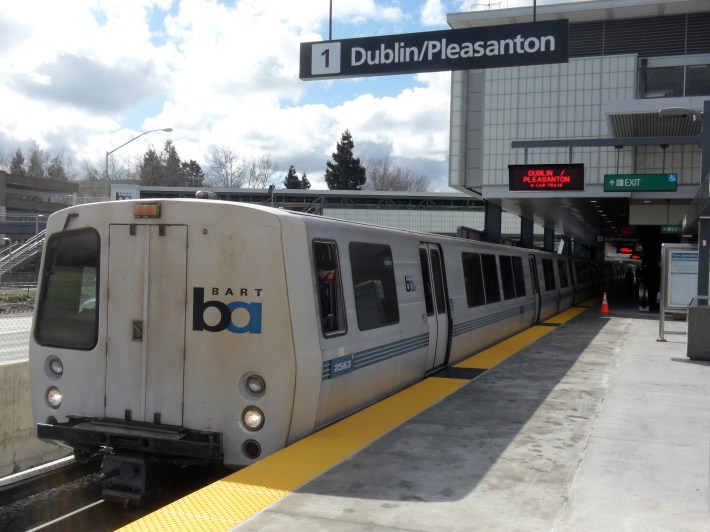Car-Hail Assists BART Passengers
4:19 PM PDT on March 21, 2016

BART's woes continued this week, with no train service this morning at the end of the Pittsburgh Bay Point line. That meant bus bridges between Pittsburg Bay Point and North Concord. But some good news came down in the early afternoon from BART's communications department:
BART will run a train every 15 minutes during commute hours between North Concord and Pittsburg/Bay Point. There will be no bus bridge during the peak hours. During off peak hours, the bus bridge will be the only option for riders. This will be the service plan while crews continue to work towards finding a solution to the electrical problem. BART successfully ran one train making many trips back and forth between the two stations on Sunday night and Monday.
At the end of last week, Streetsblog brought you the latest from advocates who blame the problems on neglect and the age of the system. Whether it's really that, or a failure to keep a sufficient supply of electrical components called thyristors, the temporary solution was a bus bridge. But for commuters who had to drive or take a bus to the suburban stations at the end of the line, transferring from one bus to another bus to a train--or from a car to a bus to a train--couldn't have been a very attractive option.
In stepped Uber, which, along with its competitor Lyft, is trying to paint itself as a complement to public transportation, rather than a generator of more car trips. Uber recently rolled out its discount carpool service, UberPOOL, to the East Bay, and the BART disruption in Contra Costa County presented another opportunity to expand. Here it is from Uber's public relations:
Due to the recent closure of some BART stations in the East Bay, we are expanding our most affordable carpooling option—UberPOOL—to connect more people to BART in the affected areas.
Uber took similar steps during the DC Metro closure last week, expanding UberPOOL over a larger area.
Coincidentally, Uber and Lyft recently held a joint public discussion with the American Public Transportation Association (APTA) about a study that shows ride-hailing reduces vehicle miles traveled by complementing public transportation use. This is how APTA described the results of the just-completed "Shared Mobility and the Transformation of Public Transit" study, conducted for them by the "Shared-Use Mobility Center:"
The ability to conveniently request, track, and pay for trips via mobile devices is a game changer in the way people get around and interact with cities. In a first-of-its-kind study, researchers looked at the traveling habits of 4,500 people in seven cities and it revealed that the more people use shared services like Lyft and Uber, the more likely they will use public transportation. In fact, among those that use Lyft and Uber, 50 percent say they use a train and 45 percent report using a bus frequently.
“This study confirms what we’ve always believed--ridesharing is an important complement to public transportation,” said David Plouffe, Chief Advisor and Board Member for Uber, in a prepared statement. “We’re excited to work with transit operators across the country to accelerate progress toward our common goal: cities with better mobility for residents [and] that are less congested, less polluted and less dependent on personal car ownership.”
That conclusion, however, seems to contradict an earlier study, done by the University of California Transportation Center at Berkeley, which found that ride-hailing pulls people away from transit.
Meanwhile, it's too soon to know how many people took advantage of the UberPOOL service in Contra Costa, but "we expect it would be helpful for commuters to have another, affordable option (compared to uberX) to complement their longer commute to the BART--particularly given that we saw a 28 percent increase in overall Uber demand on Thursday versus the previous Thursday," explained Laura Zapata, a spokeswoman for Uber.
In a sense, there's nothing really new about sharing cars during transit breakdowns. Past BART and other city transit strikes and malfunctions have brought formal and informal car pooling. And while the jury is still out on whether Uber and Lyft, on the whole, reduce or increase miles driven, it seems that at least during this particular transit mess, car-hailing is giving people another option. And it seems likely that ride-hailing is going to work hand-in-glove with transit in the future. Whatever the case, at least one of the central conclusions of the APTA study--that transit agencies need to think of themselves as mobility agencies and not as agencies that move trains and buses--makes perfect sense.
Meanwhile, BART is still searching for the cause of the electrical surges and looking for replacement thyristors.
Stay in touch
Sign up for our free newsletter



